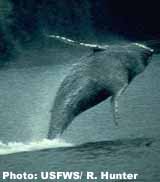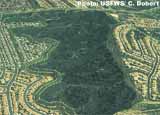|
Habitat
Protection
The mantra of many conservation efforts is that species
cannot survive without habitat. Therefore, efforts to
conserve species have often necessarily begun by identifying
the habitats those species rely on and conserving those
lands. These efforts stirred a lengthy academic debate over
the value of conserving one large site which might be
self-sustaining and avoid challenges smaller sites face -
such as management of invasive species, versus the value of
conserving many smaller sites where you might conserve more
of the habitat known to be used by species and by conserving
multiple sites there might be a degree of redundancy in the
effort rather than relying on the performance of a single
site. This debate is known as the SLOSS (Single Large or
Several Small) question and ultimately both approaches have
their advantages.
|
 .jpg)
Thousands of people travel
to see whales - both in captivity (e.g. Seaworld) and in the
wild.
|
|
Role of
Disturbance
More recently habitat conservation efforts
have recognized that simply setting land aside and managing
the site as a wild area is not sufficient to achieve lofty
conservation goals. The habitats that species rely on can
often be maintained through intensive management
interventions, but plant and wildlife communities have
evolved to take advantage of large-scale processes that
create disturbance. Disturbances like fire, windstorms and
even disease outbreaks create gaps in communities that
provide opportunities for new communities to develop and
often for the diversity of the community to increase.
|

|
|
Animal Extinctions and Declines
Animal populations fluctuate naturally, some
more than others. Populations might increase in response
to a particularly good food year, while declines would
accompany a poor food year or when predators are
abundant. When a species' population reaches zero
individuals it is extinct. Many species become doomed for
eventual extinction far before the last individual is lost as
the "effective population size" may reach zero
before the actual population if males and females can't locate
each other or if the final population is skewed such that
mating is impossible. While extinctions are a
natural feature of biological systems, extinctions are
relatively rare. Focused "extinction events" such as
the one that eliminated the dinosaurs millions of years ago
have occurred only a handful of times in geologic history and
have typically been followed by rapid evolution of new
species. Humans have had a large impact on the populations of
many different types of animals. While we have recorded steep
population declines for many species, with island species
suffering the worst fates. Many believe that the rates of
extinction we are experiencing today are unprecedented in
geologic history and may ultimately impact human populations.
(read more ...)
|
.jpg)
Passenger pigeons were
once abundant throughout North America. Their colonial
roosting made them easy targets for hunters which eventually
caused their extinction.
|
|
Human Impacts on Animals
As human population continues to expand the
conflicts between human habitat and animal habitat grow.
Cities expanding into the countryside impact habitat that
formerly served as home to various species. Large
wide-ranging animals like wolves, bears and elephants are
often the first to be impacted by declines in habitat quality
and quantity. Their size means they need lots of food, to find
that food animals often have to roam great distances and feed
on different types of food at different times of the year. As
individuals are forced to use smaller and smaller areas they
begin to influence the populations of their prey.
(read more ...)
|

Wildlife often depend on
particular types of habitat. This image shows the
impacts of urban sprawl on the California Gnatcatcher's
habitat.
|

